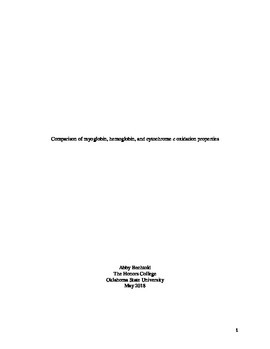| dc.contributor.author | Bechtold, Abby | |
| dc.date.accessioned | 2019-02-06T19:54:42Z | |
| dc.date.available | 2019-02-06T19:54:42Z | |
| dc.date.issued | 2018-05-04 | |
| dc.identifier | oksd_bechtold_HT_2018 | |
| dc.identifier.uri | https://hdl.handle.net/11244/317143 | |
| dc.description.abstract | Objective: Myoglobin is the primary sarcoplasmic protein responsible for beef color. However, hemoglobin and cytochrome c also contributes to a lesser extent. The redox form of myoglobin can influence beef color. For example, the presence of predominant oxymyoglobin form can impart bright red color while deoxymyoglobin can give dark-red color. The oxidation of deoxy- and oxymyoglobin can result in brown metmyoglobin. Previous research has noted that oxidation processes in meat can accelerate protein and lipid oxidation. However, limited studies have compared oxidation properties of all three proteins that can contribute to beef color. Therefore, the goal of this study was to determine hemoglobin, myoglobin, and cytochrome c oxidation in-vitro. | |
| dc.description.abstract | Method: Equine myoglobin, bovine hemoglobin and bovine cytochrome c (0.15 mM) were reduced separately by sodium hydrosulfite. Following reduction, all three proteins were passed through PD-10 desalting columns to remove residual hydrosulfite. Myoglobin, hemoglobin, and cytochrome c was confirmed using absorbance at 525 nm. Oxyhemoglobin, oxymyoglobin, and reduced cytochrome c was incubated at 4 and 25°C and the oxidation properties of proteins were recorded on d 0, 1, 2, 3, 4, and 5 at 4°C, while reading was taken 12 h interval for 96 h at 25°C. Samples were scanned spectrophotometrically at specific incubation times from 400 to 700 nm using a Shimadzu spectrophotometer. Since all three proteins differ in their oxidation-reduction peaks, the ratio of oxidation to reduction was calculated to compare oxidation properties. The experiment was replicated three times and the data were analyzed using the Mixed Procedure of SAS. | |
| dc.description.abstract | Result: At both temperatures, there were differences (P < 0.05) in oxidation properties of hemoglobin, myoglobin, and cytochrome c. Myoglobin had greater oxidation, followed by hemoglobin and cytochrome c (myoglobin > hemoglobin > cytochrome c; P < 0.05). Cytochrome c was very stable compared with other two proteins. | |
| dc.description.abstract | Conclusion: The results suggest that redox stability of myoglobin, hemoglobin, and cytochrome c are different. Future research determining the inter-relationship between protein oxidation will help to understand beef discoloration. | |
| dc.format | application/pdf | |
| dc.language | en_US | |
| dc.rights | Copyright is held by the author who has granted the Oklahoma State University Library the non-exclusive right to share this material in its institutional repository. Contact Digital Library Services at lib-dls@okstate.edu or 405-744-9161 for the permission policy on the use, reproduction or distribution of this material. | |
| dc.title | Comparison of myoglobin, hemoglobin, and cytochrome c oxidation properties | |
| osu.filename | oksd_bechtold_HT_2018.pdf | |
| osu.accesstype | Open Access | |
| dc.type.genre | Honors Thesis | |
| dc.type.material | Text | |
| dc.contributor.director | Ramanathan, Ranjith | |
| dc.contributor.facultyreader | Mafi, Gretchen | |
| thesis.degree.discipline | Animal and Food Science | |
| thesis.degree.grantor | Oklahoma State University | |
